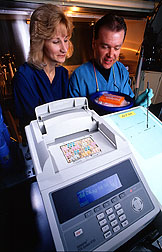Gene-Based Test for Johne's Disease
If you aren't familiar with Johne's disease--the most costly disease facing the dairy cattle industry right now--you aren't alone.
Johne's (pronounced YO-nees) disease, which costs the U.S. dairy industry more than $1.5 billion annually, is caused by a bacterium that infects ruminant animals. Mycobacterium paratuberculosis is related to, but different from, the organism that causes cattle tuberculosis.
USDA's National Animal Health Monitoring Survey (NAHMS) Dairy 1996 Study reports that 45 percent of dairy producers were either unaware of Johne's disease or recognized the name but knew little about it.
Currently, producers must rely on a test that detects antibodies in blood, but these antibodies don't show up until cows have been infected for several years. That's why Agricultural Research Service microbiologists Judith R. Stabel and Jay L.E. Ellingson at the National Animal Disease Center in Ames, Iowa, are developing a new, faster diagnostic test using the genetic sequence of M. paratuberculosis.
ARS has applied for a patent, and a Maryland microbiological diagnostics company has shown interest in further development of this work.
There are two stages of Johne's infection: clinical, in which cows show mild to severe signs of disease, and subclinical, when they have no visible signs of disease but are infected with the bacteria.
In the disease's early stages, it's difficult to visually identify infected cows because they may appear to be eating normally, even though their milk production drops. As the disease progresses, however, cows usually develop severe diarrhea, resulting in death.
"Johne's has had a bad connotation among dairy producers. It was the kiss of death if it was known to be in a herd," says Wisconsin dairy producer Mark Crave. He and his three brothers operate a 600-cow dairy farm in Waterloo, Wisconsin.
The NAHMS study also reports that about 22 percent of U.S. dairies are infected with the Johne's bacterium. The disease seems more common in larger herds. It is found in about 40 percent of herds with at least 300 cows, compared to less than 20 percent of herds with less than 50 cows.
Crave says there's more interaction among dairy farms nowadays--a factor that could have helped spread the disease.
"Until about 10 years ago, dairy farms were more isolated and had fewer visitors. Cattle were born and stayed on the same farm," says Crave. "But today there are more cows bought outside the family farm. We also have a lot of visitors to the farms, including salespeople and veterinarians. The size of the average dairy herd has increased, too," he says.
The disease also threatens beef producers.
"Johne's is something beef cattle producers know about, but they don't think it will happen to their operations," says Bill Engelbrecht, a beef producer in Henry, Illinois. "It's like cancer: We just don't think it will hit close to home. But if it does, it's devastating."
"Johne's is spread in three ways. Infected cows can pass the organism to their unborn fetuses, calves may eat food contaminated with infected manure, or they may drink contaminated milk from an infected cow," says Stabel.
Humans should not be concerned about contracting the Johne's bacteria from drinking pasteurized milk, she says. Stabel did extensive studies in 1996 that proved the dairy industry's flow-through pasteurization--continuously heating milk to a specific temperature--kills M. paratuberculosis.
The dairy industry is concerned about Johne's--not only because of its prevalence, but because it starts as an infection in calves and shows no visible signs until 2 to 5 years later. Once the disease is established in a herd, there's no cure. Even when there are no visible signs of disease, about 90 percent of dairy cows may test positive--meaning they carry the M. paratuberculosis organism.
"A test using the Johne's gene sequence would work with any sample: tissue, feces, milk, or blood. It's fast, too, giving results in 2 to 3 days compared to 10 to 12 weeks for fecal culturing techniques--another often-used test for Johne's," Stabel says. "The industry needs this kind of speed and accuracy in diagnosing infected animals for prevention to be successful."
Ellingson has identified and sequenced a gene known as the hspX gene. This discovery is the first scientific evidence of a heat shock-like molecular chaperone protein that appears to protect the bacteria from the cow's immune system.
He and Stabel have included this gene in a gene probe and have already developed a useful diagnostic tool for veterinary medicine. While they are still studying exactly how this gene functions, they are in the preliminary stages of developing a genetic vaccine for Johne's disease. Until now, only two other gene sequences of M. paratuberculosis have been reported. These were developed by English and Belgian researchers in the early 1990s.--ByLinda Cooke McGraw, Agricultural Research Service Information Staff.
Judith R. Stabel and Jay L. E. Ellingson are in the USDA-ARS Zoonotic Diseases Research Unit, National Animal Disease Center, P.O. Box 70, Ames, IA 50010; fax (515) 239-8458,
[Stabel] phone (515) 239-8304.
[Ellingson] phone (515) 239-8233.
"Gene-Based Test for Johne's Disease" was published in the October 1998 issue of Agricultural Research magazine. Click here to see this issue's table of contents.







